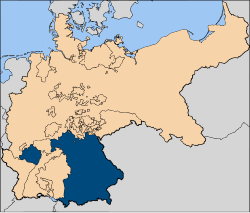Bavaria
Bavaria (/bəˈvɛəriə/; German: [Bayern] Error: {{Lang}}: text has italic markup (help), [ˈbaɪɐn]), officially the Free State of Bavaria (German: [Freistaat Bayern] Error: {{Lang}}: text has italic markup (help), [ˈfʁaɪʃtaːt ˈbaɪɐn] (![]() listen); Bavarian: Freistoot Bayern), is a State (Bundesland) of Germany. The territory of this state is the largest of the 16 German states. The state capital is Munich with 1.5 million people. About 13.1 million people live in Bavaria.
listen); Bavarian: Freistoot Bayern), is a State (Bundesland) of Germany. The territory of this state is the largest of the 16 German states. The state capital is Munich with 1.5 million people. About 13.1 million people live in Bavaria.
| Anthem: Bayernhymne (German) "Hymn of Bavaria" | |
| Coordinates: 48°46′39″N 11°25′52″E / 48.77750°N 11.43111°E | |
| Country | Germany |
| Capital | Munich |
| Government | |
| • Body | Landtag of Bavaria |
| • Minister-President | Markus Söder (CSU) |
| • Governing parties | CSU / FW |
| • Bundesrat votes | 6 (of 69) |
| Area | |
| • Total | 70,550.19 km2 (27,239.58 sq mi) |
| Population (2019-12-31)[1] | |
| • Total | 13,124,737 |
| • Density | 186/km2 (480/sq mi) |
| Population | |
| • Official languages | |
| Time zone | UTC+1 (CET) |
| • Summer (DST) | UTC+2 (CEST) |
| ISO 3166 code | DE-BY |
| GRP (nominal) | €633 billion (2019)[2] |
| GRP per capita | €48,000 (2019) |
| NUTS Region | DE2 |
| HDI (2018) | 0.947[3] very high · 6th of 16 |
| Website | https://www.bayern.de |
Like many German states, Bavaria was once independent. Ludwig II of Bavaria was its last independent king. Bavaria joined the German Empire in 1871.
Structure
Bavaria has seven parts: Oberbayern (Upper Bavaria), Niederbayern (Lower Bavaria), Schwaben (Swabia), Mittelfranken (Middle Franconia), Unterfranken (Lower Franconia), Oberfranken (Upper Franconia) and Oberpfalz (Upper Palatinate). Bavaria has 71 districts and 25 free cities.
The highest point is the Zugspitze, which is also the highest mountain in Germany. Munich is the largest city, the second biggest city is Nuremberg (Nürnberg), which is famous for its gingerbread, a kind of Christmas bread that is often shaped like a Christmas tree, a snowman or Santa Claus.
Pope Benedict XVI was born in Bavaria.
Administrative divisions
Administrative regions
Bavaria is divided into seven administrative regions called Regierungsbezirke (singular Regierungsbezirk). For every Administrative region there is a state agency called Bezirksregierung (district government).
Districts (Bezirke)
Bavaria has "Bezirke" or districts; the others are the Landkreise and the Gemeinden or Städte. The Bezirke in Bavaria are identical with the Regierungsbezirke. In the other larger states of Germany, there are only Regierungsbezirke as administrative divisions and no self-governing entities at the level of the Regierungsbezirke as the Bezirke in Bavaria.
Population and area
| Region | Coat of arms | Capital | Population (2019)[4] | Area (km2) | No. municipalities | |||
|---|---|---|---|---|---|---|---|---|
| Lower Bavaria | 
|
Landshut | 1,244,169 | 9.48% | 10,330 | 14.6% | 258 | 12.5% |
| Lower Franconia | 
|
Würzburg | 1,317,619 | 10.46% | 8,531 | 12.1% | 308 | 15.0% |
| Upper Franconia | 
|
Bayreuth | 1,065,371 | 8.49% | 7,231 | 10.2% | 214 | 10.4% |
| Middle Franconia | 
|
Ansbach | 1,775,169 | 13.65% | 7,245 | 10.3% | 210 | 10.2% |
| Upper Palatinate | 
|
Regensburg | 1,112,102 | 8.60% | 9,691 | 13.7% | 226 | 11.0% |
| Swabia | 
|
Augsburg | 1,899,442 | 14.21% | 9,992 | 14.2% | 340 | 16.5% |
| Upper Bavaria | 
|
Munich | 4,710,865 | 35.12% | 17,530 | 24.8% | 500 | 24.3% |
| Total | 13,124,737 | 100.0% | 70,549 | 100.0% | 2,056 | 100.0% | ||
Districts
Bavaria is made up of 71 rural districts that are comparable to counties, as well as the 25 independent cities, both of which share the same administrative responsibilities and duties.
Rural districts:
Independent cities:
Municipalities
The 71 rural districts are on the lowest level divided into 2,031 regular municipalities. Together with the 25 independent cities, there are a total of 2,056 municipalities in Bavaria.
In 44 of the 71 rural districts, there are a total of 215 unincorporated areas (as of 1 January 2005), not belonging to any municipality, all unsettled and unpopulated, mostly forested areas, but also four lakes (Chiemsee-without islands, Starnberger See-without islands, Roseninsel, Ammersee, which are the three largest lakes of Bavaria, and Waginger See).
Major cities and towns
| City | Region | Population (2000) |
Population (2005) |
Population (2010) |
Population (2015) |
Change (%) |
|---|---|---|---|---|---|---|
| Munich | Upper Bavaria | 1,210,223 | 1,259,677 | 1,353,186 | 1,450,381 | +11.81 |
| Nuremberg | Middle Franconia | 488,400 | 499,237 | 505,664 | 509,975 | +3.53 |
| Augsburg | Swabia | 254,982 | 262,676 | 264,708 | 286,374 | +3.81 |
| Regensburg | Upper Palatinate | 125,676 | 129,859 | 135,520 | 145,465 | +7.83 |
| Ingolstadt | Upper Bavaria | 115,722 | 121,314 | 125,088 | 132,438 | +8.09 |
| Würzburg | Lower Franconia | 127,966 | 133,906 | 133,799 | 124,873 | +4.56 |
| Fürth | Middle Franconia | 110,477 | 113,422 | 114,628 | 124,171 | +3.76 |
| Erlangen | Middle Franconia | 100,778 | 103,197 | 105,629 | 108,336 | +4.81 |
| Bayreuth | Upper Franconia | 74,153 | 73,997 | 72,683 | 72,148 | −1.98 |
| Bamberg | Upper Franconia | 69,036 | 70,081 | 70,004 | 73,331 | +1.40 |
| Aschaffenburg | Lower Franconia | 67,592 | 68,642 | 68,678 | 68,986 | +1.61 |
| Landshut | Lower Bavaria | 58,746 | 61,368 | 63,258 | 69,211 | +7.68 |
| Kempten | Swabia | 61,389 | 61,360 | 62,060 | 66,947 | +1.09 |
| Rosenheim | Upper Bavaria | 58,908 | 60,226 | 61,299 | 61,844 | +4.06 |
| Neu-Ulm | Swabia | 50,188 | 51,410 | 53,504 | 57,237 | +6.61 |
| Schweinfurt | Lower Franconia | 54,325 | 54,273 | 53,415 | 51,969 | −1.68 |
| Passau | Lower Bavaria | 50,536 | 50,651 | 50,594 | 50,566 | +0.11 |
| Freising | Upper Bavaria | 40,890 | 42,854 | 45,223 | 46,963 | +10.60 |
| Straubing | Lower Bavaria | 44,014 | 44,633 | 44,450 | 46,806 | +0.99 |
| Dachau | Upper Bavaria | 38,398 | 39,922 | 42,954 | 46,705 | +11.87 |
Source: Bayerisches Landesamt für Statistik und Datenverarbeitung[5][6]
Bavaria Media
A map of Bavaria in the German Empire, which was formed in 1871 and endured until 1918
A memorial to soldiers who died in World War I and World War II in Kröning, Bavaria
The Bavarian Alps (foreground) and Tyrol in Austria (background), including the Inn valley (center), Kaisergebirge (left), Pendling (right), and the snow-capped High Tauern (center left)
A native Bavarian language speaker recorded in Germany
Notes
References
- ↑ "Bevölkerung: Gemeinden, Geschlecht, Quartale, Jahr". Bayerisches Landesamt für Statistik und Datenverarbeitung (in Deutsch). August 2020. Archived from the original on 18 December 2020. Retrieved 29 April 2021.
- ↑ "GDP NRW official statistics". Archived from the original on 25 June 2020. Retrieved 17 February 2019.
- ↑ "Sub-national HDI - Area Database - Global Data Lab". hdi.globaldatalab.org. Archived from the original on 23 September 2018. Retrieved 13 September 2018.
- ↑ https://www.statistik.bayern.de/mam/produkte/veroffentlichungen/statistische_berichte/a1200c_201944.xla
- ↑ Bayerisches Landesamt für Statistik, München 2015 (30 August 2015). "Bayerisches Landesamt für Statistik – GENESIS-Online Bayern". bayern.de. Archived from the original on 9 December 2012. Retrieved 9 May 2014.
- ↑ Bayerisches Landesamt für Statistik, München 2017 (23 April 2017). "Bayerisches Landesamt für Statistik – GENESIS-Online Bayern". bayern.de. Archived from the original on 9 December 2012. Retrieved 9 May 2014.
Sources
 Chisholm, Hugh, ed. (1911). . Encyclopædia Britannica. Vol. 3 (Eleventh ed.). Cambridge University Press.
Chisholm, Hugh, ed. (1911). . Encyclopædia Britannica. Vol. 3 (Eleventh ed.). Cambridge University Press. {{cite encyclopedia}}: Cite has empty unknown parameter:|coauthors=(help)
Other websites
| Wikimedia Commons has media related to Lua error in Module:Commons_link at line 62: attempt to index field 'wikibase' (a nil value).. |
| Wikivoyage has a travel guide about: Bavaria |
- Official government website
- Official website of Bayern Tourismus Marketing GmbH Archived 2014-05-01 at the Wayback Machine
- Bavarian Studies in History and Culture
- Außenwirtschaftsportal Bayern
- Statistics
 Geographic data related to Bavaria at OpenStreetMap
Geographic data related to Bavaria at OpenStreetMap















